Irene Y. Chen
Treatment Non-Adherence Bias in Clinical Machine Learning: A Real-World Study on Hypertension Medication
Feb 26, 2025
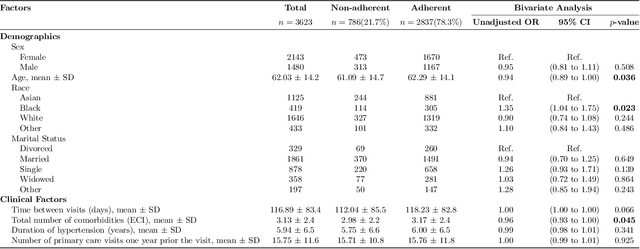
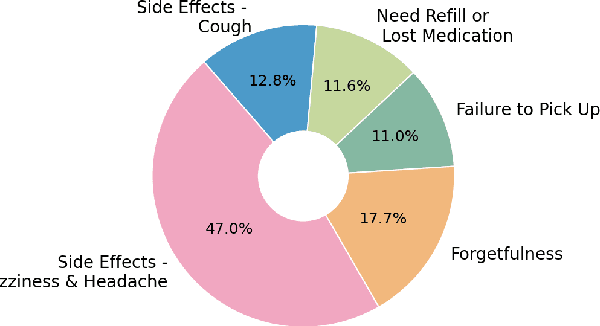
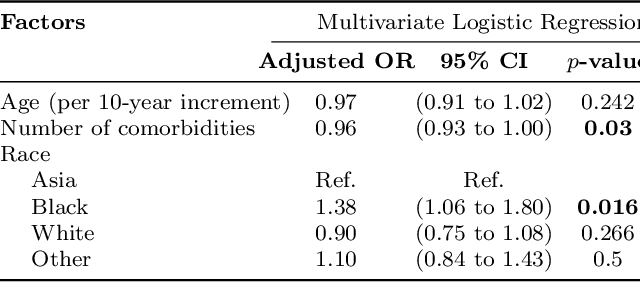
Abstract:Machine learning systems trained on electronic health records (EHRs) increasingly guide treatment decisions, but their reliability depends on the critical assumption that patients follow the prescribed treatments recorded in EHRs. Using EHR data from 3,623 hypertension patients, we investigate how treatment non-adherence introduces implicit bias that can fundamentally distort both causal inference and predictive modeling. By extracting patient adherence information from clinical notes using a large language model, we identify 786 patients (21.7%) with medication non-adherence. We further uncover key demographic and clinical factors associated with non-adherence, as well as patient-reported reasons including side effects and difficulties obtaining refills. Our findings demonstrate that this implicit bias can not only reverse estimated treatment effects, but also degrade model performance by up to 5% while disproportionately affecting vulnerable populations by exacerbating disparities in decision outcomes and model error rates. This highlights the importance of accounting for treatment non-adherence in developing responsible and equitable clinical machine learning systems.
Enhancing Semi-supervised Learning with Noisy Zero-shot Pseudolabels
Feb 18, 2025



Abstract:Semi-supervised learning (SSL) leverages limited labeled data alongside abundant unlabeled data to address labeling costs in machine learning. While recent foundation models enable zero-shot inference, attempts to integrate these capabilities into SSL through pseudo-labeling have shown mixed results due to unreliable zero-shot predictions. We present ZMT (Zero-Shot Multi-Task Learning), a framework that jointly optimizes zero-shot pseudo-labels and unsupervised representation learning objectives from contemporary SSL approaches. Our method introduces a multi-task learning-based mechanism that incorporates pseudo-labels while ensuring robustness to varying pseudo-label quality. Experiments across 8 datasets in vision, language, and audio domains demonstrate that ZMT reduces error by up to 56% compared to traditional SSL methods, with particularly compelling results when pseudo-labels are noisy and unreliable. ZMT represents a significant step toward making semi-supervised learning more effective and accessible in resource-constrained environments.
Deep Speech Synthesis from Multimodal Articulatory Representations
Dec 17, 2024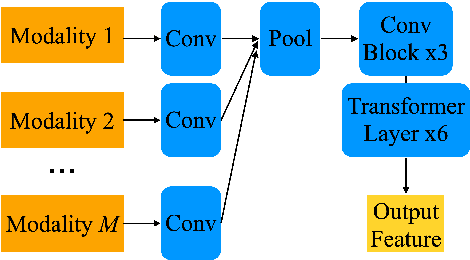

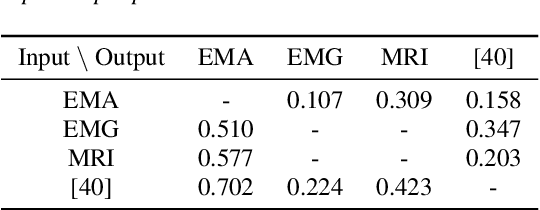

Abstract:The amount of articulatory data available for training deep learning models is much less compared to acoustic speech data. In order to improve articulatory-to-acoustic synthesis performance in these low-resource settings, we propose a multimodal pre-training framework. On single-speaker speech synthesis tasks from real-time magnetic resonance imaging and surface electromyography inputs, the intelligibility of synthesized outputs improves noticeably. For example, compared to prior work, utilizing our proposed transfer learning methods improves the MRI-to-speech performance by 36% word error rate. In addition to these intelligibility results, our multimodal pre-trained models consistently outperform unimodal baselines on three objective and subjective synthesis quality metrics.
Generative AI in Medicine
Dec 13, 2024

Abstract:The increased capabilities of generative AI have dramatically expanded its possible use cases in medicine. We provide a comprehensive overview of generative AI use cases for clinicians, patients, clinical trial organizers, researchers, and trainees. We then discuss the many challenges -- including maintaining privacy and security, improving transparency and interpretability, upholding equity, and rigorously evaluating models -- which must be overcome to realize this potential, and the open research directions they give rise to.
The Data Addition Dilemma
Aug 08, 2024Abstract:In many machine learning for healthcare tasks, standard datasets are constructed by amassing data across many, often fundamentally dissimilar, sources. But when does adding more data help, and when does it hinder progress on desired model outcomes in real-world settings? We identify this situation as the \textit{Data Addition Dilemma}, demonstrating that adding training data in this multi-source scaling context can at times result in reduced overall accuracy, uncertain fairness outcomes, and reduced worst-subgroup performance. We find that this possibly arises from an empirically observed trade-off between model performance improvements due to data scaling and model deterioration from distribution shift. We thus establish baseline strategies for navigating this dilemma, introducing distribution shift heuristics to guide decision-making on which data sources to add in data scaling, in order to yield the expected model performance improvements. We conclude with a discussion of the required considerations for data collection and suggestions for studying data composition and scale in the age of increasingly larger models.
Updating the Minimum Information about CLinical Artificial Intelligence (MI-CLAIM) checklist for generative modeling research
Mar 05, 2024Abstract:Recent advances in generative models, including large language models (LLMs), vision language models (VLMs), and diffusion models, have accelerated the field of natural language and image processing in medicine and marked a significant paradigm shift in how biomedical models can be developed and deployed. While these models are highly adaptable to new tasks, scaling and evaluating their usage presents new challenges not addressed in previous frameworks. In particular, the ability of these models to produce useful outputs with little to no specialized training data ("zero-" or "few-shot" approaches), as well as the open-ended nature of their outputs, necessitate the development of updated guidelines in using and evaluating these models. In response to gaps in standards and best practices for the development of clinical AI tools identified by US Executive Order 141103 and several emerging national networks for clinical AI evaluation, we begin to formalize some of these guidelines by building on the "Minimum information about clinical artificial intelligence modeling" (MI-CLAIM) checklist. The MI-CLAIM checklist, originally developed in 2020, provided a set of six steps with guidelines on the minimum information necessary to encourage transparent, reproducible research for artificial intelligence (AI) in medicine. Here, we propose modifications to the original checklist that highlight differences in training, evaluation, interpretability, and reproducibility of generative models compared to traditional AI models for clinical research. This updated checklist also seeks to clarify cohort selection reporting and adds additional items on alignment with ethical standards.
Identifying Reasons for Contraceptive Switching from Real-World Data Using Large Language Models
Feb 06, 2024Abstract:Prescription contraceptives play a critical role in supporting women's reproductive health. With nearly 50 million women in the United States using contraceptives, understanding the factors that drive contraceptives selection and switching is of significant interest. However, many factors related to medication switching are often only captured in unstructured clinical notes and can be difficult to extract. Here, we evaluate the zero-shot abilities of a recently developed large language model, GPT-4 (via HIPAA-compliant Microsoft Azure API), to identify reasons for switching between classes of contraceptives from the UCSF Information Commons clinical notes dataset. We demonstrate that GPT-4 can accurately extract reasons for contraceptive switching, outperforming baseline BERT-based models with microF1 scores of 0.849 and 0.881 for contraceptive start and stop extraction, respectively. Human evaluation of GPT-4-extracted reasons for switching showed 91.4% accuracy, with minimal hallucinations. Using extracted reasons, we identified patient preference, adverse events, and insurance as key reasons for switching using unsupervised topic modeling approaches. Notably, we also showed using our approach that "weight gain/mood change" and "insurance coverage" are disproportionately found as reasons for contraceptive switching in specific demographic populations. Our code and supplemental data are available at https://github.com/BMiao10/contraceptive-switching.
Designing Guiding Principles for NLP for Healthcare: A Case Study of Maternal Health
Dec 19, 2023



Abstract:Objective: An ethical framework for the use of large language models (LLMs) is urgently needed to shape how natural language processing (NLP) tools are used for healthcare applications. Drawing directly from the voices of those most affected, we propose a set of guiding principles for the use of NLP in healthcare, with examples based on applications in maternal health. Materials and Methods: We led an interactive session centered on an LLM-based chatbot demonstration during a full-day workshop with 39 participants, and additionally surveyed 30 healthcare workers and 30 birthing people about their values, needs, and perceptions of AI and LLMs. We conducted quantitative and qualitative analyses of the interactive discussions to consolidate our findings into a set of guiding principles. Results: Using the case study of maternal health, we propose nine principles for ethical use of LLMs, grouped into three categories: (i) contextual significance, (ii) measurements, and (iii) who/what is valued. We describe rationales underlying these principles and provide practical advice. Discussion: Healthcare faces existing challenges including the balance of power in clinician-patient relationships, systemic health disparities, historical injustices, and economic constraints. Our principles serve as a framework for surfacing key considerations when deploying LLMs in medicine, as well as providing a methodological pattern for other researchers to follow. Conclusion: This set of principles can serve as a resource to practitioners working on maternal health and other healthcare fields to emphasize the importance of technical nuance, historical context, and inclusive design when developing LLMs for use in clinical settings.
Generating Drug Repurposing Hypotheses through the Combination of Disease-Specific Hypergraphs
Nov 16, 2023


Abstract:The drug development pipeline for a new compound can last 10-20 years and cost over 10 billion. Drug repurposing offers a more time- and cost-effective alternative. Computational approaches based on biomedical knowledge graph representations have recently yielded new drug repurposing hypotheses. In this study, we present a novel, disease-specific hypergraph representation learning technique to derive contextual embeddings of biological pathways of various lengths but that all start at any given drug and all end at the disease of interest. Further, we extend this method to multi-disease hypergraphs. To determine the repurposing potential of each of the 1,522 drugs, we derive drug-specific distributions of cosine similarity values and ultimately consider the median for ranking. Cosine similarity values are computed between (1) all biological pathways starting at the considered drug and ending at the disease of interest and (2) all biological pathways starting at drugs currently prescribed against that disease and ending at the disease of interest. We illustrate our approach with Alzheimer's disease (AD) and two of its risk factors: hypertension (HTN) and type 2 diabetes (T2D). We compare each drug's rank across four hypergraph settings (single- or multi-disease): AD only, AD + HTN, AD + T2D, and AD + HTN + T2D. Notably, our framework led to the identification of two promising drugs whose repurposing potential was significantly higher in hypergraphs combining two diseases: dapagliflozin (antidiabetic; moved up, from top 32$\%$ to top 7$\%$, across all considered drugs) and debrisoquine (antihypertensive; moved up, from top 76$\%$ to top 23$\%$). Our approach serves as a hypothesis generation tool, to be paired with a validation pipeline relying on laboratory experiments and semi-automated parsing of the biomedical literature.
Closing the Gap in High-Risk Pregnancy Care Using Machine Learning and Human-AI Collaboration
May 26, 2023



Abstract:Health insurers often use algorithms to identify members who would benefit from care and condition management programs, which provide personalized, high-touch clinical support. Timely, accurate, and seamless integration between algorithmic identification and clinical intervention depends on effective collaboration between the system designers and nurse care managers. We focus on a high-risk pregnancy (HRP) program designed to reduce the likelihood of adverse prenatal, perinatal, and postnatal events and describe how we overcome three challenges of HRP programs as articulated by nurse care managers; (1) early detection of pregnancy, (2) accurate identification of impactable high-risk members, and (3) provision of explainable indicators to supplement predictions. We propose a novel algorithm for pregnancy identification that identifies pregnancies 57 days earlier than previous code-based models in a retrospective study. We then build a model to predict impactable pregnancy complications that achieves an AUROC of 0.760. Models for pregnancy identification and complications are then integrated into a proposed user interface. In a set of user studies, we collected quantitative and qualitative feedback from nurses on the utility of the predictions combined with clinical information driving the predictions on triaging members for the HRP program.
 Add to Chrome
Add to Chrome Add to Firefox
Add to Firefox Add to Edge
Add to Edge